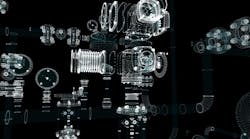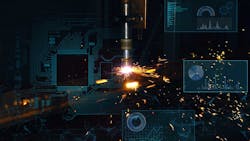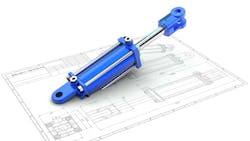The use of sensors and software in motion control systems — including those comprised of hydraulic, pneumatic and electronic components — is on the rise, bringing a range of performance benefits.
Integration of sensors enables increased precision and control of components, leading to improved efficiency, as well as the ability to collect performance data. Software can be used to help collect and analyze this data while also enabling programming of components and systems to provide various performance features.
READ MORE: Software Brings Efficiency Gains and Ease of Use
Understanding how to utilize sensors and software in motion control systems is vital to taking advantage of the benefits they can provide and will be necessary as their use continues to grow. As such, the Power & Motion team — in conjunction with its design and engineering focused affiliate publications — will present "The Value of Sensors & Software in Motion Control" on June 22.
This series of webinars provides a technical and educational look at how sensors and software are being utilized and the benefits of doing so.
The Benefits of Integrating Sensors and Software into Motion Control Systems
This webinar brings together a panel of industry experts to discuss how they are employing sensors and software, and the benefits of doing so. They also offer their expertise on how to properly integrate these technologies as well as what further developments may be possible in the coming years.
The four panelists come from a range of companies working with sensors, hydraulics and software, enabling them to provide their unique perspectives on working with and integrating these technologies:
- Oliver Lythgoe, Chief Marketing Officer at Fetis Group
- Joern Strasser, Business Manager - Speed Sensors at Rheintacho
- August "Gus" Meyers, Branch Manager for Mobile Automation at SIKO Products Inc.
- Dave Boeldt, Product Manager at Bosch Rexroth.
Emerging Sensor Options in Robotic Actuation
An increased desire to automate processes, particularly in manufacturing, is leading to a rise in use of robotics. With this comes the need to not only ensure they operate as desired but also work safely alongside humans. Incorporation of sensors can help to achieve these goals.
In this webinar, Kyle Syndergaard, Application Engineer at Schaeffler Group USA Inc., offers insight into the use of sensors in robotics. By incorporating sensors, a robot's ability to "feel" can be be improved which leads to more capabilities and the potential for use in new applications.
Robots do not have the same tactile feedback as humans. But Syndergaard points out that by employing smart sensorization, there is the potential to give robots tactile feedback closer to that of humans. Sensors can also provide situational awareness, particularly beneficial for mobile robots, to ensure safe movements.
Accelerating Electrification Through Precision Motion Control and Software
Electrification is on the rise, particularly for heavy-duty mobile equipment such as construction and mining machinery. With that is coming the need to re-evaluate the technologies utilized and in some cases even replacing traditional components and systems with other technologies.
READ MORE: Construction Equipment Digs Deeper into Electrification
Eric Berg, Senior Project Engineer at Moog Construction, offers examples of how Moog has worked with heavy machinery OEMs to electrify their equipment and the role sensors and software have played when doing so.
Highlighted in this webinar is Moog's collaboration with Bobcat to electrify its T7X compact track loader. To do so, the company eliminated all hydraulics typically used on this type of machine, replacing them with electro-mechanical actuators, a traction motor and drive and other electronic components. In addition, actuator and drive sensors were utilized to help provide more control while software in the vehicle controller provides communication with the sensors and programmability of various machine functions.
The Role of Sensors and Software in Achieving Efficiency Improvements
Efficiency is becoming an increasingly important feature for machines of all types as it can aid with productivity and sustainability efforts.
In this webinar, Steve Weber, System Application Engineering Lead, and Cory Fisher, Engineering Manager, at Sun Hydraulics overview development of a new hydraulic valve technology and how its use of sensors and software help to provide efficiency gains in various applications.
Besides creating a new cartridge valve design, the company has incorporated pressure transducers to help the valve reduce energy use. Software plays a role as well, offering the ability to provide more controllability which Fisher said will be particularly beneficial to help novice machine operators be more productive.
How to Select the Right Sensor for a Hydraulic Cylinder
Understanding how to select the right sensor is key to ensuring desired performance benefits can be achieved. In this webinar, Mark Hoffman, Vice President of Sales & Marketing at Rota Engineering, overviews sensor options for hydraulic cylinders and how to choose the appropriate option.
One of the key considerations Hoffman points to for choosing the right sensor is knowing the application in which it will be used. With this comes the need to understand what parameters are going to be measured as well as system pressures. It is also necessary to know what type of environment the sensor and hydraulic cylinder may be used in as this will determine if certain certifications or durability requirements need to be met.
Another factor to consider is the electrical termination — will an M12 or Deutsch connector be utilized? Will the sensor and/or the hydraulic cylinder be submerged underwater? These aspects must also be taken into consideration, among several others, to ensure the sensor provides desired performance.




